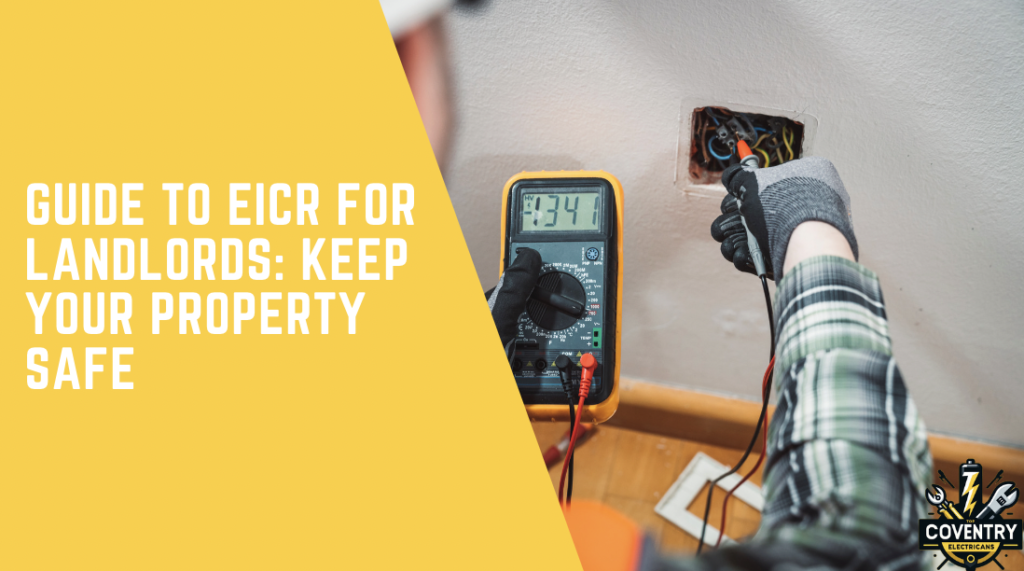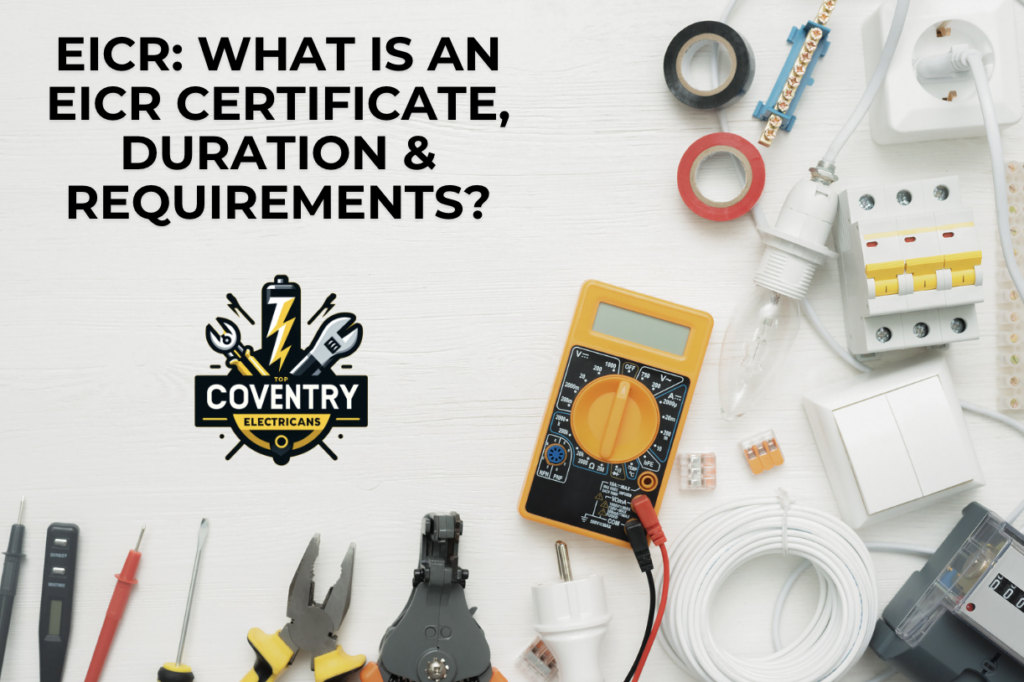Share this post
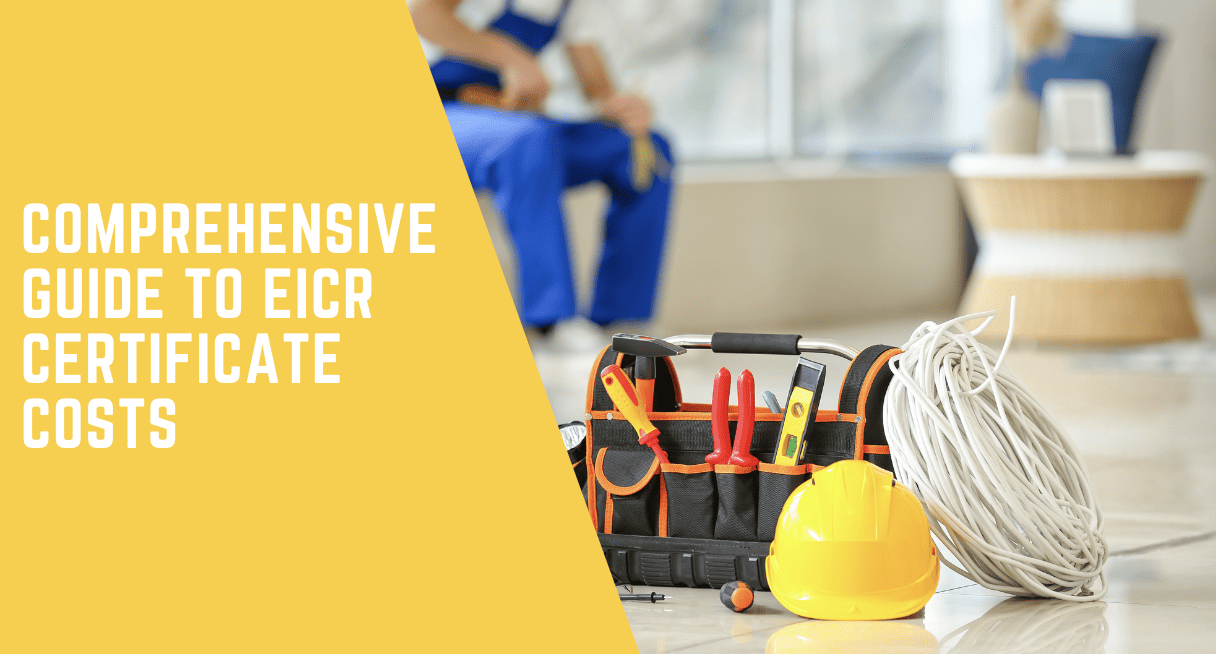

Comprehensive Guide To EICR Certificate Costs
- ,
- , EICR
How Much Does An EICR Cost?
EICR Certificate Costs vary, starting from £100 to £230 for apartments based on wiring quality and size, reaching £150 to £300+ for houses. This cost encompasses a professional electrician’s inspection of all electrical systems within the property, ensuring they meet safety standards. Upon passing the inspection, a certificate is issued, confirming compliance.
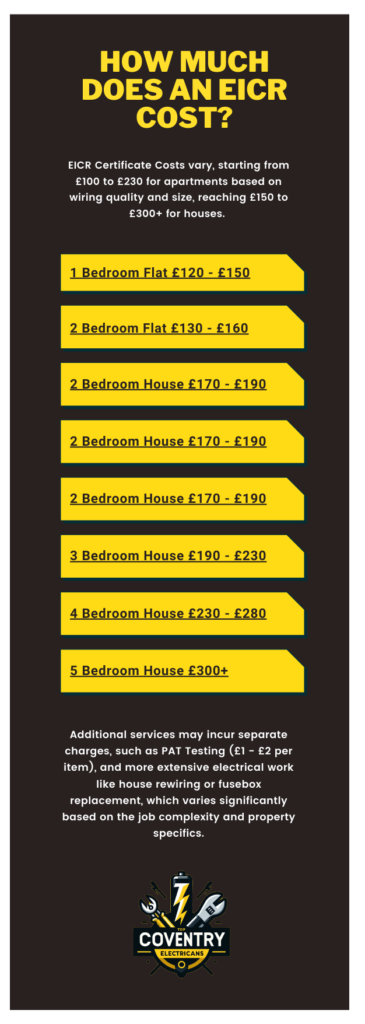
Introduction to EICR Certificates
Definition and Importance
Electrical Installation Condition Reports (EICR) are vital assessments qualified electricians conduct to ensure the safety and compliance of electrical installations within a property. These reports identify any deficiencies against the UK standard for the safety of electrical installations, helping to prevent electrical hazards.
Legal Requirements and Safety Benefits
EICRs are not just a best practice but a legal requirement in specific contexts, such as for rented properties. They offer significant safety benefits, including the early detection of potential electrical dangers, compliance with legal standards, and peace of mind for property owners and occupants.
Understanding EICR Costs
EICR Certificate Cost Overview
The cost of an Electrical Installation Condition Report (EICR) varies primarily with the size and type of property, starting from around £125 for a small one-bedroom flat to over £300 for larger, detached homes with five bedrooms. This pricing structure ensures property owners can anticipate the cost based on their specific property type.
Included in Your EICR Cost
The fee for an EICR covers the professional services of a certified electrician who will conduct a comprehensive inspection of your property’s electrical systems. This includes all necessary tests to ensure compliance with current electrical standards. Successful inspections result in the issuing of an EICR certificate, affirming the property’s electrical safety.
Detailed Cost Breakdown
To provide a clearer understanding of how EICR costs are structured according to property size, consider the following table:
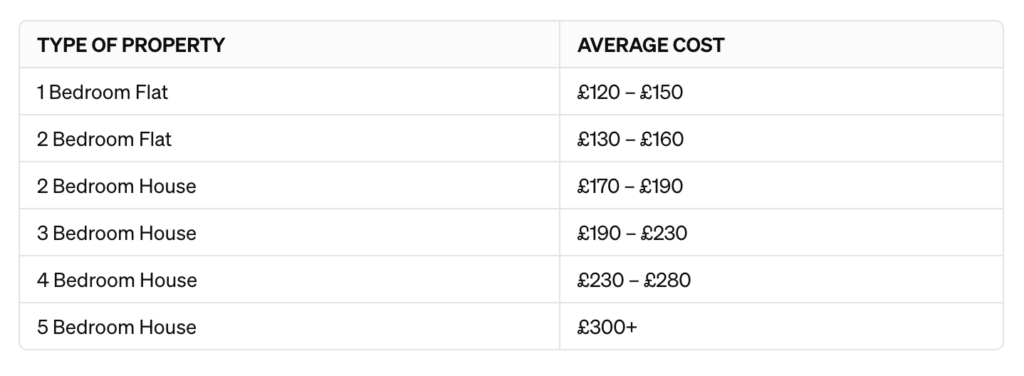
Additional services may incur separate charges, such as PAT Testing (£1 – £2 per item), and more extensive electrical work like house rewiring or fusebox replacement, which varies significantly based on the job complexity and property specifics.
Average Costs for Domestic and Commercial Properties
The cost of an EICR varies based on the type and size of the property. For domestic properties, prices may vary depending on the number of bedrooms, while commercial properties might incur different rates due to their complexity and size. It’s crucial to consider these variations when budgeting for an EICR.
Breakdown of Costs: Inspection, Testing, and Certification
EICR costs are typically segmented into inspection, testing, and certification phases. The inspection thoroughly examines electrical installations and tests to ensure they meet safety standards. Finally, a certificate is issued to document the condition of the installations.
- Inspection: Visual examination of electrical installations.
- Testing: Detailed testing of electrical circuits and systems.
- Certification: Issuance of the EICR document.
Factors Influencing the Price of an EICR
Several factors can affect EICR costs, including:
- Property size: Larger properties require more time to inspect.
- Age and condition of the electrical installation: Older installations may require more in-depth examination.
- Location: Prices can vary across the UK by region.
Understanding these cost components and factors can help property owners budget more effectively for their EICR. Obtaining quotes from several qualified electricians is also advisable to ensure competitive pricing.
The EICR Process Explained
Step-by-Step Guide to Electrical Safety Checks
The EICR process includes several key steps, from the initial booking to the final report issuance. Property owners must understand each phase to ensure the inspection is thorough and compliant with UK standards.
- Booking an Inspection: Contact a certified electrician to schedule an EICR.
- Initial Inspection: The electrician conducts a visual examination of accessible electrical systems.
- Circuit Testing: Detailed testing of wiring and electrical circuits.
- Issue Finding: Identification of any electrical faults or deviations from safety standards.
- Report Compilation: The electrician compiles findings into the EICR document.
- Review and Recommendations: The report includes any necessary corrective actions.
Initial Inspection to Final Reporting
The initial inspection focuses on visually checking the condition of electrical installations. At the same time, the final reporting phase culminates in the EICR document, which details the inspection findings and any recommended actions.
What Electricians Look For: Key Inspection Points
Electricians assess several critical areas during an EICR, including:
- Wiring systems and their condition.
- Protection devices for adequacy and effectiveness.
- Any signs of wear and tear or damage.
- Compliance with current electrical standards.
DIY Safety Checks: Precautions and Limitations
While some basic checks can be performed by property owners, such as testing smoke detectors and ensuring no visible wires are damaged, a professional should conduct comprehensive electrical inspections. Due to the specialised knowledge and tools required, DIY checks cannot substitute for a formal EICR.
Frequency and Regulations
Understanding the frequency and adhering to regulations for EICR is crucial for property safety and compliance. The regularity of these checks varies based on property type, usage, and jurisdiction, with specific guidelines for residential, commercial, and rented properties. It’s essential to stay informed about the latest regulations and standards, which may dictate the intervals at which EICRs must be conducted to ensure ongoing electrical safety and compliance with legal requirements.
How Often Should You Get an EICR?
It’s recommended to obtain an EICR at regular intervals, varying by property type:
- For homeowners, every 10 years or upon changing tenants.
- For rented properties, every 5 years or with each change of occupancy.
- Commercial properties may have different requirements based on their specific regulations, but every 3 years is advised.
You can find out more on on this and how long EICR certificates last.
Staying current with these inspections ensures compliance with safety standards and legal requirements.
Regulatory Framework for EICR Compliance
The regulatory framework for EICR compliance is set by UK law, emphasising landlords’ and property owners’ responsibility to ensure electrical safety. This includes the Electricity at Work Regulations 1989 and various housing standards. Compliance ensures the safety of occupants and protects property owners from legal repercussions.
For more detailed content on each subheading, incorporating specific instructions and guidelines as you’ve outlined would involve a deeper dive into each topic, ensuring accuracy and alignment with your requirements.
The Comprehensive EICR Checklist
A thorough EICR encompasses a wide range of checks to ensure that all aspects of a property’s electrical systems are safe and up to code. This comprehensive evaluation includes examining the condition of the wiring, the functionality of the electrical panel, safety device performance, and the integrity of outlets and switches.
What’s Included in an EICR?
An EICR includes detailed assessments of:
- The adequacy of earthing and bonding.
- The suitability of the switchgear and control gear.
- The serviceability of switches, sockets, and light fixtures.
- The type of wiring system and its condition.
- The presence of adequate identification and notices.
- The extent of any wear and tear, damage, or other deterioration.
- The changes in use of the premises that have led to, or might lead to, deficiencies in the electrical system.
Detailed Inspection Areas and Assessment Criteria
The EICR process involves an in-depth review of several key areas, including electrical circuits, protection systems, and device functionality. The assessment criteria focus on safety compliance, the condition of electrical installations, and the adequacy of current protective measures. Each area is meticulously evaluated against strict standards to identify potential risks or non-compliance issues.
Benefits of Obtaining an EICR
Securing an EICR offers numerous advantages, from enhancing electrical safety to ensuring regulatory compliance. It identifies potential electrical hazards before they become serious, provides peace of mind to property owners, and can be crucial for insurance purposes. Also, for landlords, it’s a legal requirement to ensure tenants’ safety and help maintain the property’s electrical systems efficiently.
If you’re a landlord and need more information, why not take a look at our helpful guide – EICR For Landlords.
Enhancing Electrical Safety and Compliance
Obtaining an EICR improves electrical safety and ensures compliance with current regulations. It recognises and mitigates potential hazards, reducing the risk of electrical fires and accidents. Compliance demonstrates a commitment to maintaining high safety standards, which is essential for the well-being of occupants.
Financial and Legal Advantages for Property Owners
For property owners, an EICR offers substantial financial and legal benefits. It can lead to lower insurance premiums by demonstrating reduced risk. Legally, it ensures adherence to electrical safety regulations, protecting against potential fines or legal action for non-compliance. Additionally, it contributes to preserving property value by ensuring the electrical systems are up-to-date and safe.
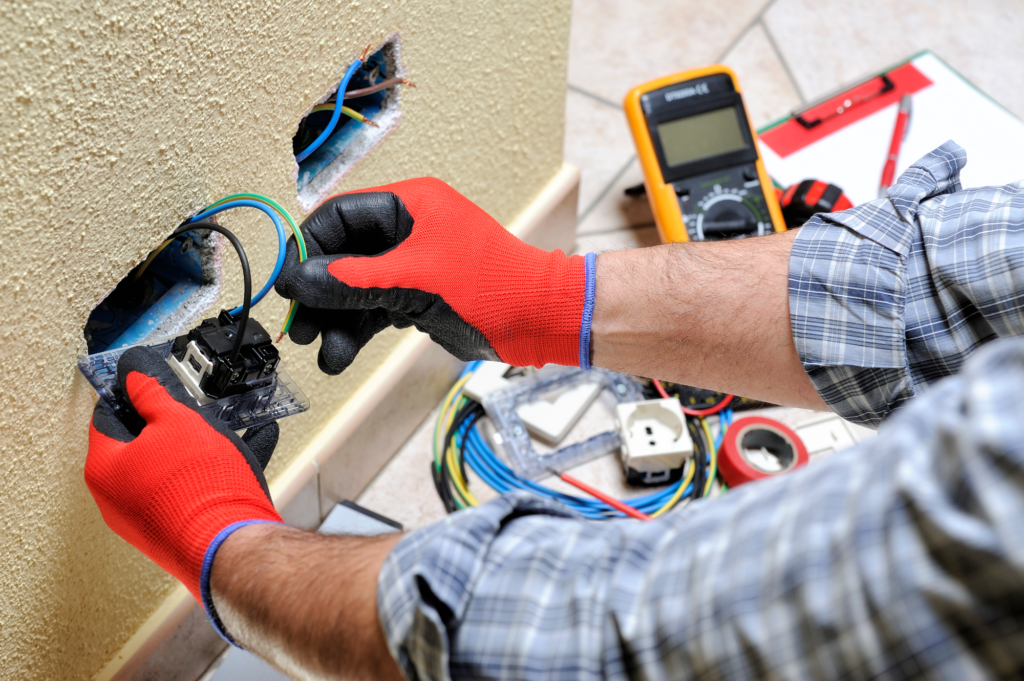
Selecting a Qualified Electrician
Choosing the right electrician is crucial for ensuring the quality and safety of your EICR.
Credentials and Competent Person Schemes
- NICEIC: National Inspection Council for Electrical Installation Contracting
- ELECSA: Offers Part P and contractor schemes
- NAPIT: National Association of Professional Inspectors and Testers
These credentials signify adherence to the latest industry standards and regulations.
Tips for Finding Trusted Electricians
- Check Credentials: Ensure they are registered with a recognisedrecognised competent person scheme.
- Read Reviews: Look for feedback from previous clients.
- Get Multiple Quotes: Compare costs and services offered.
- Ask for References: Speak to former clients about their experiences.
Selecting a qualified electrician ensures your property’s electrical safety and compliance. Look for professionals with the proper credentials and a solid reputation to conduct your EICR.
Addressing and Rectifying Electrical Defects
Proactively addressing and rectifying electrical defects is crucial for maintaining safety and compliance. This section outlines common issues and guides the estimated costs associated with repairs and upgrades.
Common Electrical Issues and Solutions
- Overloaded Circuits: Install additional circuits or upgrade existing ones to handle more capacity.
- Faulty Wiring: Replacement of old or damaged wiring to prevent hazards.
- Tripping Breakers: Assessment and correction of issues causing frequent tripping, such as circuit overload.
- Improper Grounding: Ensuring all electrical installations are properly grounded to enhance safety.
Estimated Costs for Repairs and Upgrades

Note: Costs can vary based on location, property size, and specific requirements.
Navigating the EICR Certification Process
This section outlines property owners’ steps to navigate the EICR certification process, from booking an inspection to understanding compliance requirements and follow-up actions.
Booking, Inspection, and Receiving Your Certificate
- Booking: Contact a certified electrician or electrical firm registered with a recognised competent person scheme.
- Inspection: The electrician comprehensively assesses the property’s electrical systems.
- Receiving Your Certificate: If your property meets the required standards after the inspection, you’ll receive an EICR certificate.
Compliance and Follow-Up Actions
- Addressing Issues: If the inspection uncovers any deficiencies, addressing these as recommended is essential.
- Documentation: Record the EICR and any remedial work undertaken for compliance.
- Regular Reviews: Schedule future inspections according to the recommended frequency to maintain compliance.
EICR FAQs: Everything You Need to Know
Navigating EICR certificate costs and requirements can be complex. Here, we address common queries to clarify essential aspects of EICR certification for property owners and landlords.
Validity, Duration, and Selling Your House
EICR validity spans 5 years for rentals and up to 10 for homeowners. The inspection’s duration varies, potentially influencing house sales by assuring buyers of electrical safety.
Differences Between EICR, EPC, and Other Certificates
EICR focuses on electrical safety, EPC rates energy efficiency, and Gas Safety Certificates ensure the safety of gas appliances, each serving distinct compliance roles.
Penalties for Non-Compliance
Non-compliance with EICR requirements can lead to legal actions and fines and potentially invalidate insurance, emphasising the importance of adherence for property owners.
Wrapping Up: Insights into EICR Certificate Costs
As we conclude our exploration of EICR Certificate Costs, let’s emphasise the critical takeaways and best practices for property owners and landlords.
Key Takeaways
- EICR costs vary based on property size and type, specifically concerning domestic and commercial distinctions.
- Budgeting effectively for an EICR involves understanding the breakdown of inspection, testing, and certification costs.
- Regular checks are a legal requirement and a proactive measure to ensure electrical safety and compliance.
- Choosing a qualified electrician is crucial for a thorough and compliant EICR.
- Addressing issues identified in an EICR can help avoid costly repairs and ensure safety.
Our guide provides a foundational understanding of EICR Certificate Costs, helping you confidently navigate the requirements and processes. If you have any questions, please don’t hesitate to get in touch with our team.

